“Israeli Strike Kills Hundreds in Hospital, Palestinians Say,” the New York Times banner headline screamed on Tuesday afternoon. The leadership of the Hamas terrorist organization could hardly have dreamed of better framing as news of the explosion and fire at Gaza’s Al-Ahli Ar hospital began to trickle out.
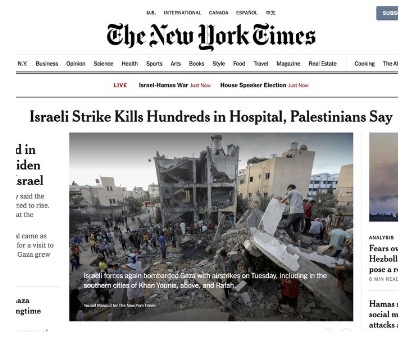
That framing included a photograph of devastating carnage that Times readers likely believed depicted damage to the hospital in question. But not only was the Times story topped with a headline framed entirely around the word of the Hamas-controlled Palestinian authorities in Gaza, the accompanying photo was not even of the hospital, but rather of a building in a city some 15 miles to the south. That, however, was only the tip of the iceberg when it comes to the New York Times’ journalistic malpractice this week.
The Headlines
While the Times led with “Israeli Strike Kills Hundreds in Hospital, Palestinians Say,” that initial headline—as is often the case with online media—didn’t last long. “Israeli” was dropped from the next version—“At Least 500 Dead in Strike on Gaza Hospital, Palestinians Say”—perhaps due to the Israeli Defense Forces’ cautious but firm pushback on the accusations. That “500” figure was changed to “hundreds” in subsequent headlines, and while yet unconfirmed, a report on Thursday citing a European Union official suggested the true number of fatalities is between 10 and 50.
“Strike” was the next word to get the ax, as visitors to the Times’ website were greeted with “Hundreds Dead in Blast at Gaza Hospital, Palestinians Say.” Eventually, the banner headline received the passive-voice treatment: “Biden Heads to Israel as Hospital Explosion Convulses Region.” Although the Times had run a separate story by that point conceding that “the cause of the blast and the precise death toll remained unclear,” a tweaked version of the original headline—“Hundreds Killed in Gaza Blast, Palestinians Say”—remained lower on the home page for several hours on Wednesday.
The Photo
While the explosion took place at the Ahli Arab Hospital in Gaza City, the caption beneath the photo on the home page early on [shown above] read, “Israeli forces again bombarded Gaza with airstrikes on Tuesday, including in the southern cities of Khan Younis, above, and Rafah.” The headline immediately above the photo, however, referenced the hospital “airstrike,” without mentioning a location. Unless readers knew the Al-Ahli Hospital was not in Khan Younis, they likely assumed they were looking at the damage of the “airstrike” referenced.
Given the rapid developments and “fog of war,” one might be inclined to overlook this unfortunate juxtaposition of the (already bad) headline and photo on the website. The problem, however, is that the Times engaged in the same egregious conduct in the print edition of the paper published the following morning. By the time that version hit newsstands, the headline of the hospital story had been updated to “BLAST KILLS HUNDREDS AT GAZA HOSPITAL: Palestinians and Israelis Blame Each Other Ahead of Biden’s Arrival,” and the main photo depicted actual victims from the explosion. But the secondary photo, below the story , was the one from Khan Younis that had been on the website the previous afternoon.
The Map
The Times’ Hamas-friendly framing of the story extended beyond the headlines and photographs; early coverage of the explosion also included a map created by the Times that was labeled “Location of Hospital Airstrike” and purported to show the location of the incident.
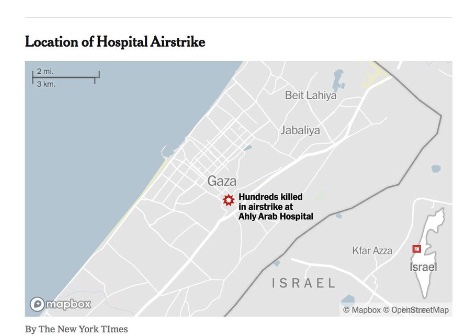
The Times quickly changed the map and the title, replacing “airstrike” with “explosion,” but editors failed to include a note or any mention of a correction.
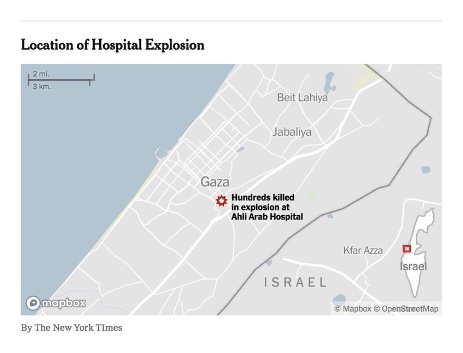
The Details
While dozens of Times reporters have undoubtedly spent a great amount of time tracking down and sifting through information about this tragic event, the paper’s coverage of the story has lent far too much credence to a Hamas-driven narrative. One article entitled “Bloody Blankets and ‘Lots of Bodies’ at a Devastated Gaza Hospital” included quotes from “videos that witnesses posted to social media,” the “Palestinian Red Crescent,” “Palestinian officials” (Hamas-controlled), and the “Health Ministry in Gaza” (Hamas-controlled). When reporters’ coverage of a war relies on sources as dubious as some of these—and fails to include any on-the-record quotes from the other side of the conflict—it is difficult to distinguish it from opinion. A few years ago, the Times solicited an essay from Sirajuddin Haqqani—deputy leader of the Taliban in Afghanistan and a wanted terrorist—entitled, “What We, the Taliban, Want.” At least in that case, the Times could fall back on the claim that “it’s just his opinion.” The news side of the paper doesn’t have that luxury.
It remains to be seen if the Times will accept responsibility for how badly it covered this incident. An update to the Times’ live coverage Wednesday afternoon noted: “As anger rises across the Middle East, President Biden appeared to endorse Israel’s denial of responsibility for the deadly blast at a Gaza hospital.” That anger has begun to manifest itself already in a number of disturbing ways, including stormed embassies and destroyed synagogues. It’s impossible to objectively assign a certain degree of culpability for stoking tensions to any one media outlet. At the same time, Tuesday was a dark day not just for the Middle East—but for the New York Times as well.
Click here for more coverage of the war in Israel.

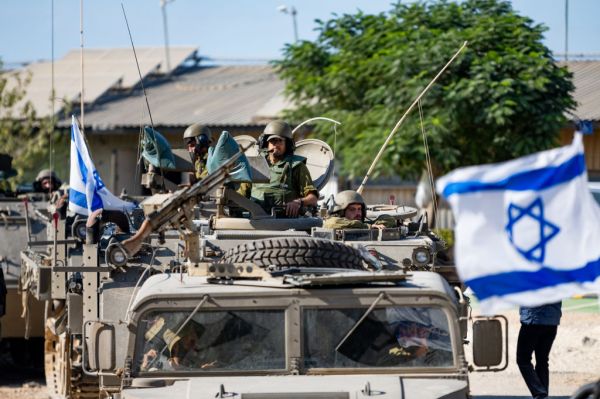
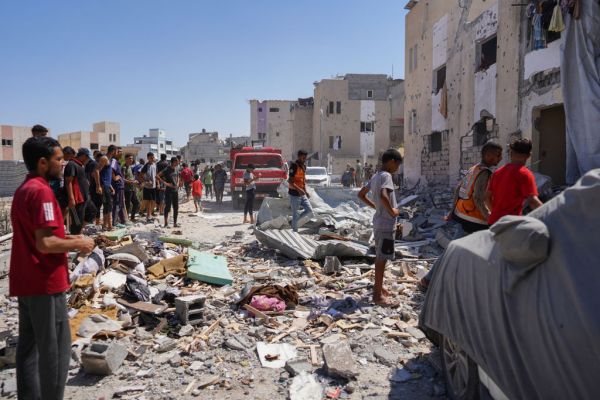




Please note that we at The Dispatch hold ourselves, our work, and our commenters to a higher standard than other places on the internet. We welcome comments that foster genuine debate or discussion—including comments critical of us or our work—but responses that include ad hominem attacks on fellow Dispatch members or are intended to stoke fear and anger may be moderated.